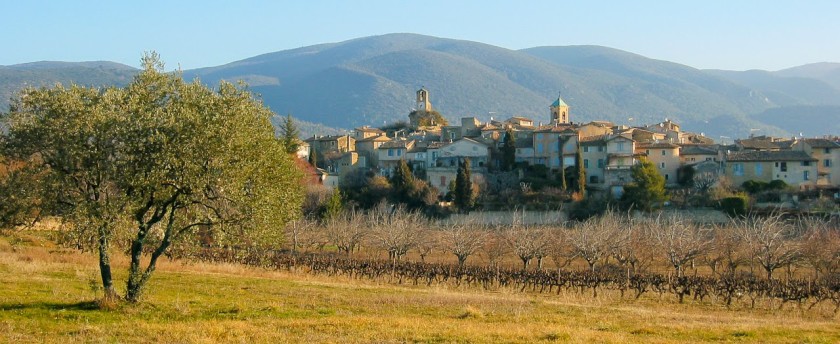
This is the first in a series of posts about buying, renting, and selling our property in Provence. It is an abbreviated version—really, Mom, it is—and a few of the names were changed. (If you want to hear the long version, you’ll have to invest in a gastronomic dinner and some very nice wine.)
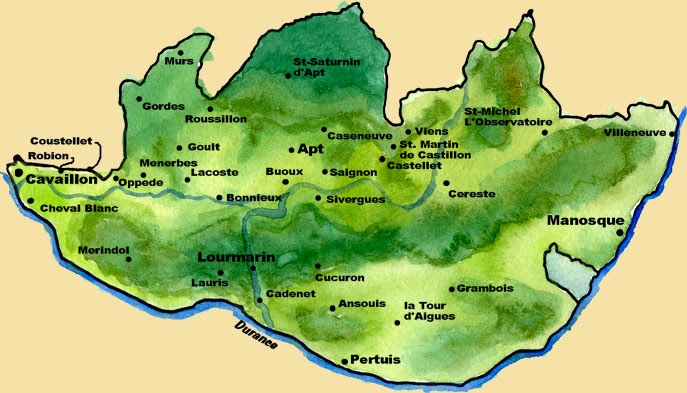 |
| Map of the Luberon. Art by A.C.M. |
Lourmarin is one of 144 villages in the whole country to be officially designated as one of “The Most Beautiful Villages in France.” Set among vineyards, olive groves, almond trees, and fields of wild herbs, this charming village is not far from extensive forests in the Luberon Natural Park and, in the summer months, from brilliantly colored rows of lavender.
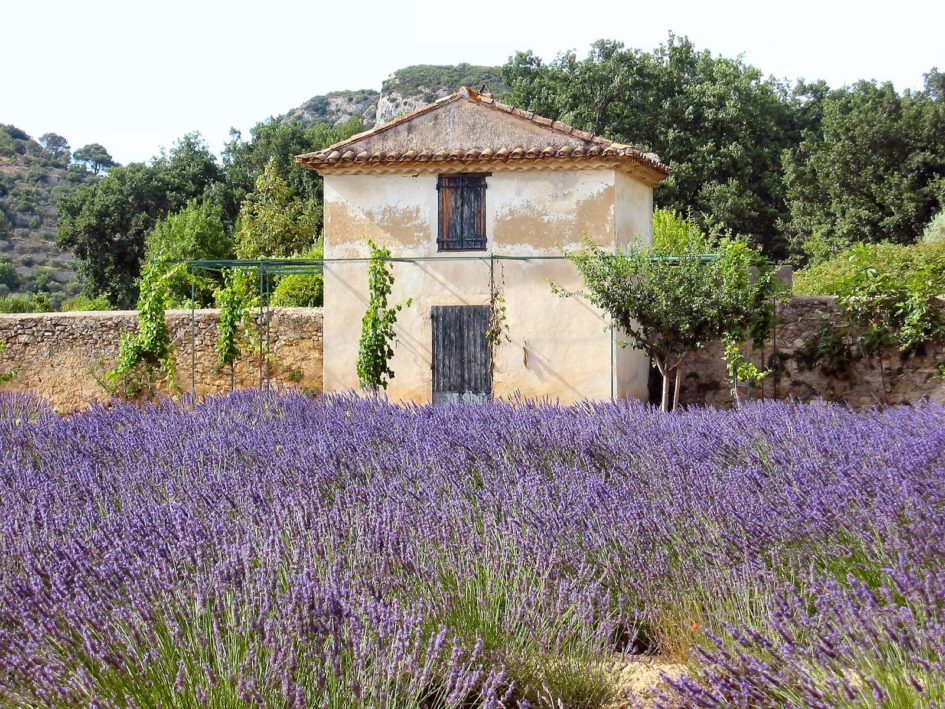 |
| Lavender field near Lourmarin. Photo by W.T. Manfull |
The village is steeped in history, culture, arts, and gastronomy. It has a 15th-16th-century château overlooking an 11th-century fortified watch tower that rises above narrow winding streets lined with narrow houses with flower boxes, galleries, shops, wine caves, cafés, tea salons, and restaurants. There is a market every Friday morning (and Tuesday evenings in the summer months). A canopy of plane trees welcomes visitors traveling from the Luberon Mountains into town or to the château and protestant church, passing by the requisite pétanque court and a huge soccer field, along the way.
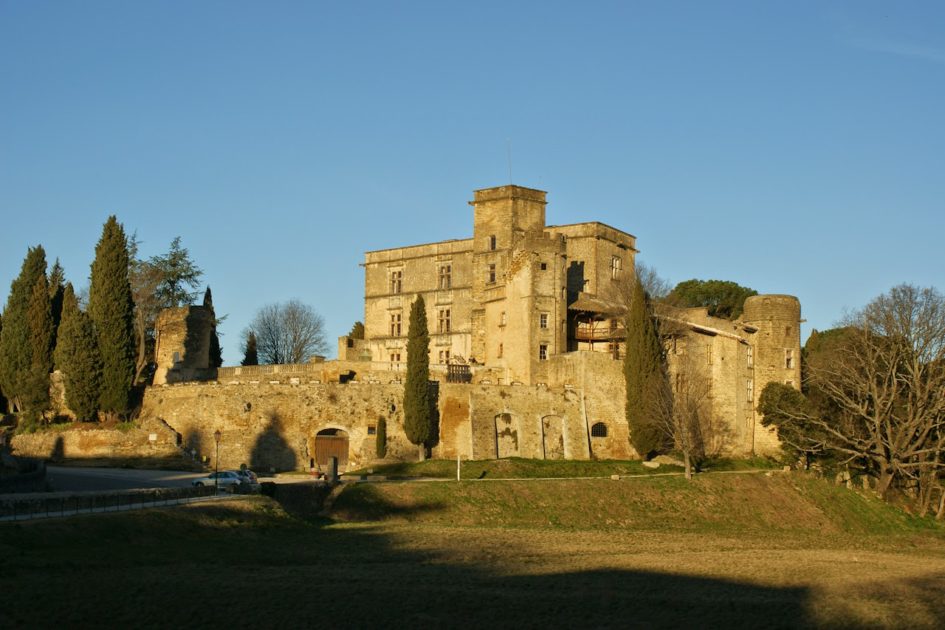 |
| Chateau de Lourmarin. Photo by W.T. Manfull |
The town’s allure is irresistible and extends well beyond its attractive surface (belying a violent past). I am not the first to say that Lourmarin exerts, for lack of better words, a force that has a profoundly calming and peaceful effect. It grounds me at my very core and I feel good, happy, and at home.
part with the vacation home that had served several generations of family before her. She informed Arnaud, a local realtor, who mentioned it to our good friends Pierre and Muriel who, in turn, told us. We were staying just a few doors down from this home, on Rue de la Juiverie.
Muriel and Pierre wanted us to see it right away, the façade at least and so did we…just for fun, bien sûr. We weren’t planning to buy property, I repeat.
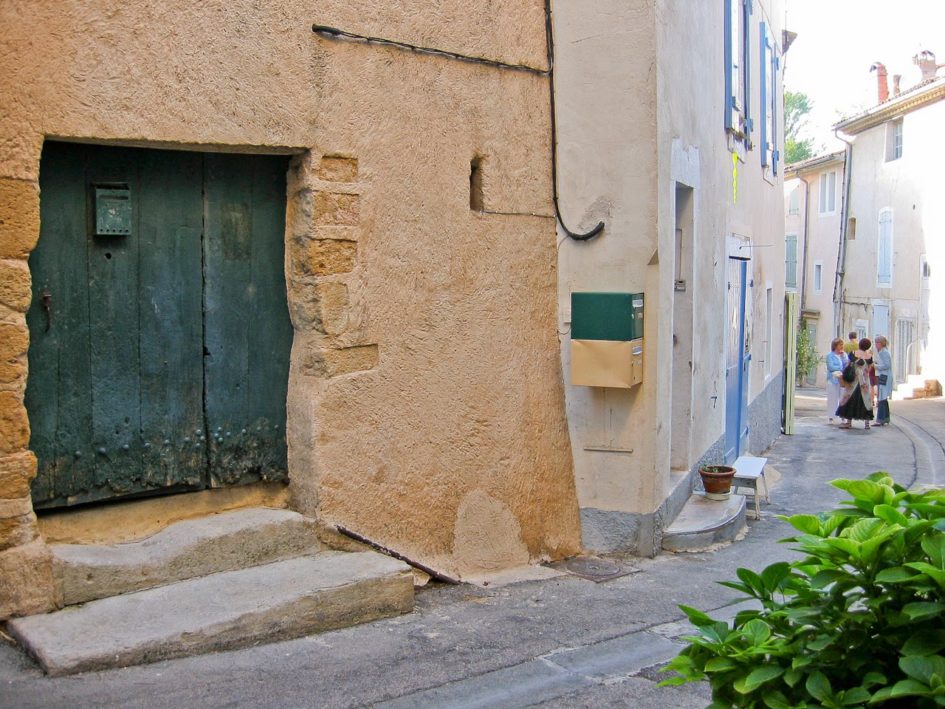 |
| Entrance to La Bonbonniere and l’Oustaloun from Rue de la Juiverie. Photo by W.T. Manfull |
We had walked past the large, rather shabby green door many times over the years, but I had never noticed it. “Keep it that way,” Pierre said (as if we already owned it) as he opened the door and we peered in to find a shadowy passageway leading to an internal courtyard. I shouldn’t have been so surprised—I have learned that Provence is full of secret gems like this one, concealed by doors and gates whose well-worn appearances belie what treasures hide behind.
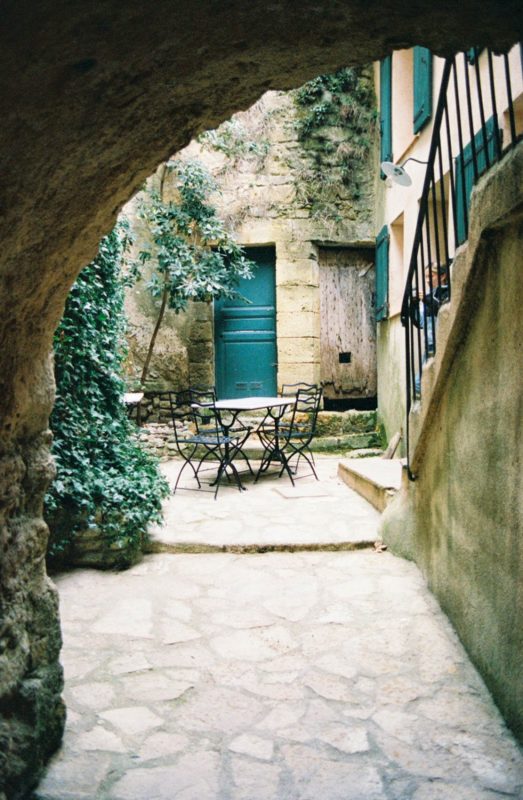 |
| The courtyard. Photo by W.T. Manfull |
We were immediately enchanted. I can’t explain exactly why. The courtyard, a small unadorned square paved with flat stones, was wedged deep in the center of a diminutive medieval city block among four tall contiguous houses. It appeared to have survived the centuries by luck more than foresight. A loving hand had not touched it in some time. But, the early spring sun seemed to focus its light directly on to this little courtyard, accentuating the ivy that climbed the walls and the small trees that graced two of the corners. Even the old pots and the weather-beaten door were not as eye-sores. It was a picture of rustic coziness, even on that chilly March afternoon. A small table and chairs beckoned us to sit down, and we did so for a long while. Inside a tiny nook in the wall, we found a candle and a frame that, when wiped clean, revealed a tattered copy of Saint Francis’ Prayer of Peace.
We made arrangements right then to see the interior of the two properties the next day.
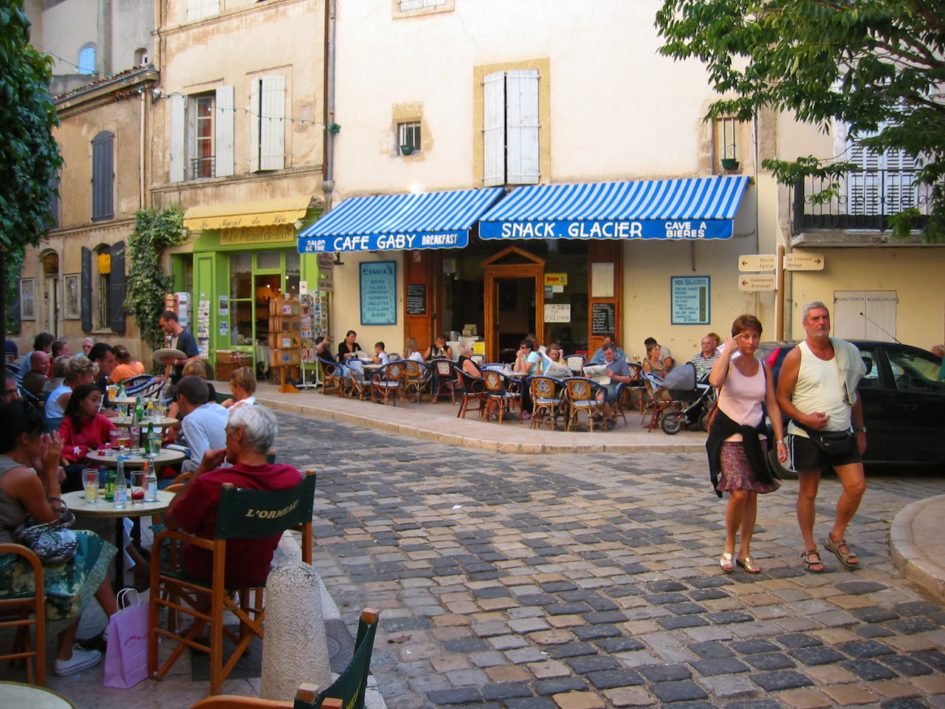 |
| Cafe Gaby in Lourmarin. Photo by W.T. Manfull |
I didn’t sleep all night. What was I thinking? A home in France, no matter how small, was not part of our financial plan. We live across the Atlantic and our day begins six hours later than the day in Provence. Who did I think I was…Peter Mayle? Frances Mayes? I didn’t even speak French! In the morning, I doused my face with cold water and headed to Café Gaby for our usual grande crème. Agence Sud Luberon, the first real estate agency in Lourmarin—which Arnaud’s father had opened some 30 years earlier—is just across from Gaby’s on the narrow main street that traverses the center of town. We would make the three-minute walk together to the unassuming green door. I was consumed with anxiety and excitement.
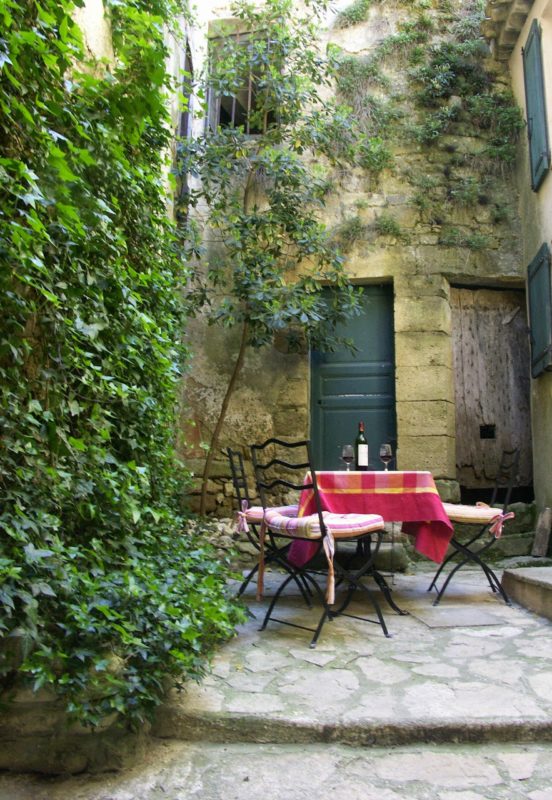 |
| The courtyard. Photo by W.T. Manfull |
The courtyard looked beautiful in the brilliant light, settling my nervous stomach, if only for a few minutes, until we crossed the threshold of the first house. There, to my great disappointment, I saw rooms that bore no resemblance to any images of Provence I carried in my head.
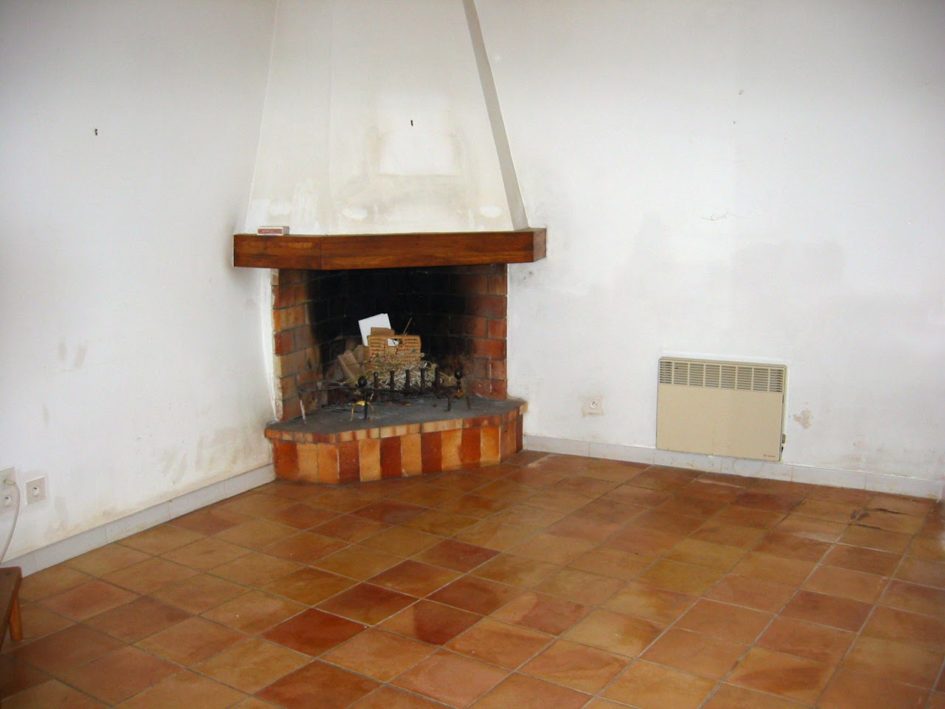 |
| La Bonbonnière living room. Photo by W.T. Manfull |
There was a small living room dominated by a nondescript fireplace in one corner and an intimidating wooden spiral staircase in another leading to a second floor. The dining area, also small, was on the right. The kitchen, uninspired if functional, was separated from the dining area by a counter. Ceramic tile, fashioned to resemble traditional Provençal clay tile, covered the ground floor. The walls begged for paint.
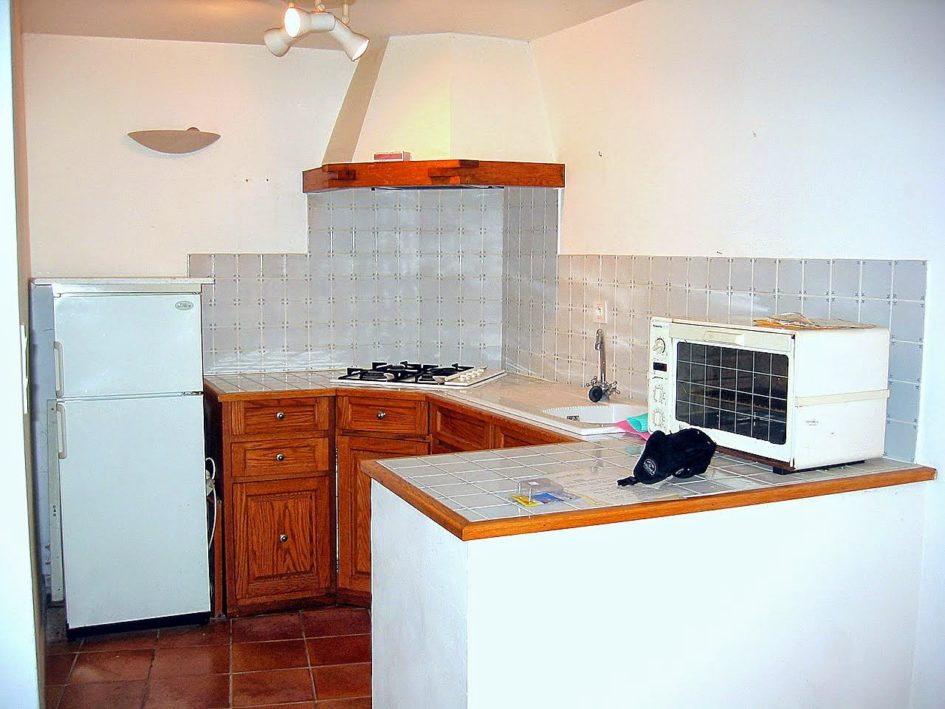 |
| La Bonbonnière kitchen. Photo by W.T. Manfull |
Up the rickety stair case, I was surprised to find a very large room with a small alcove. A queen-sized bed at the center of the main room left plenty of space for a bureau and desk. A single bed was nestled into the alcove. Two skylights brought in the morning sun (and later we would learn, the occasional cat). Two large windows overlooked the charming courtyard. There were built-in shelves and white-washed thick plaster walls. I could easily imagine the three of us sleeping up here.
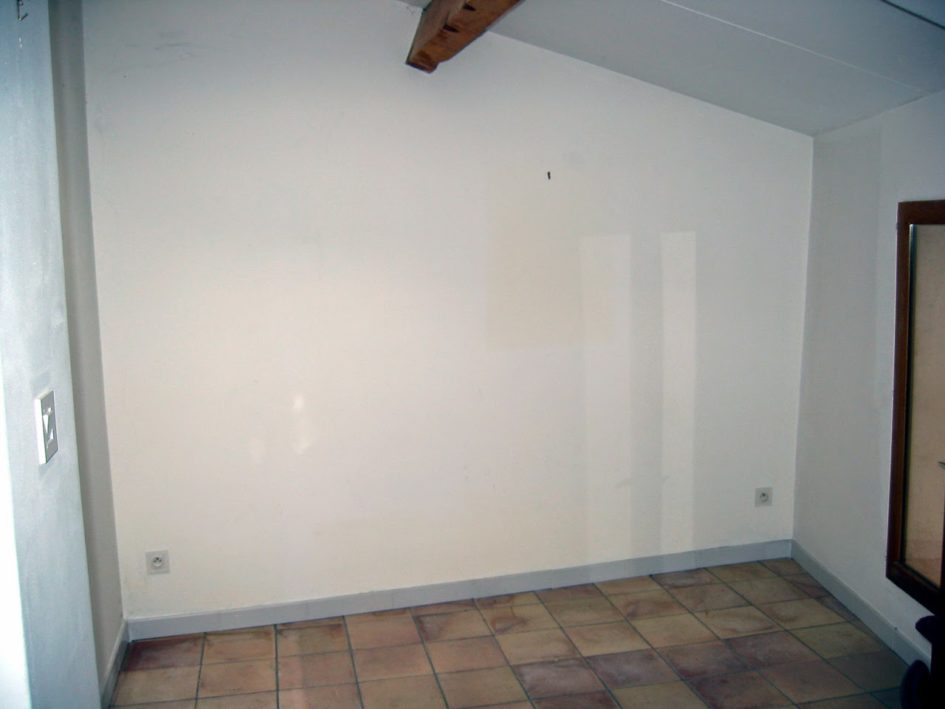 |
| La Bonbonnière upstairs. Photo by W.T. Manfull |
This was most definitely not the quintessential Provençal maison village I had hoped for, but it was a solid home that, with the right paint, tile, and fabrics, could be transformed to something more akin to those images of life in Provence that were firmly ingrained in my mind’s eye. Oui, bien sûr.
The staircase demarcated a tiny foyer where I envisioned guests hanging their hats and discarding their shoes as they entered what could become our home.
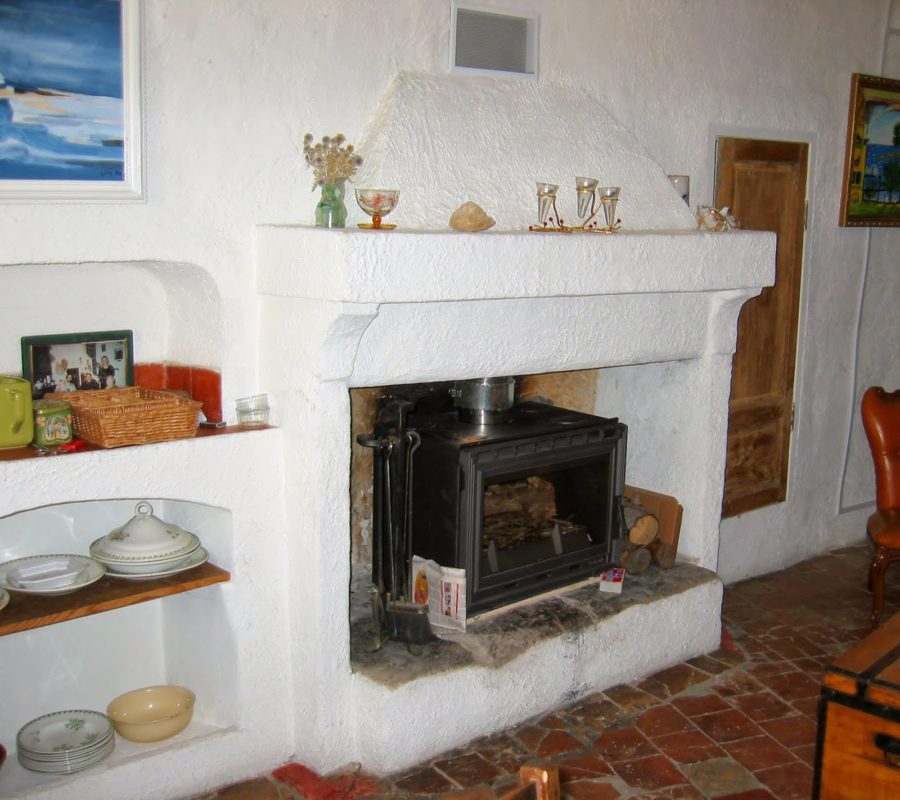 |
| L’Oustaloun living room. Photo by W.T. Manfull |
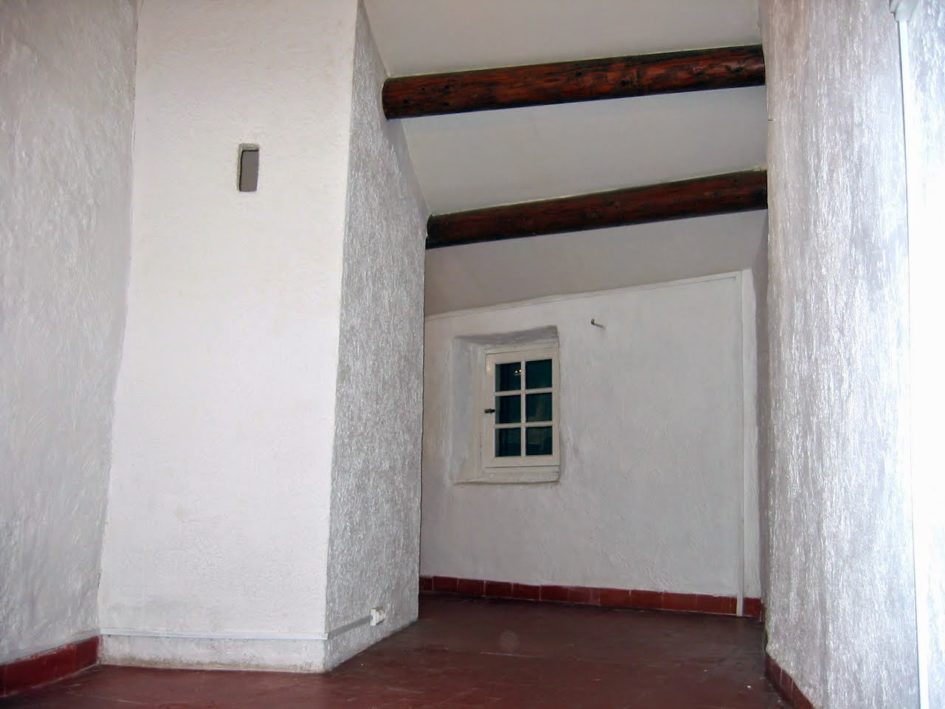 |
| L’Oustaloun upstairs with “monolith” on the left. Photo by W.T. Manfull |
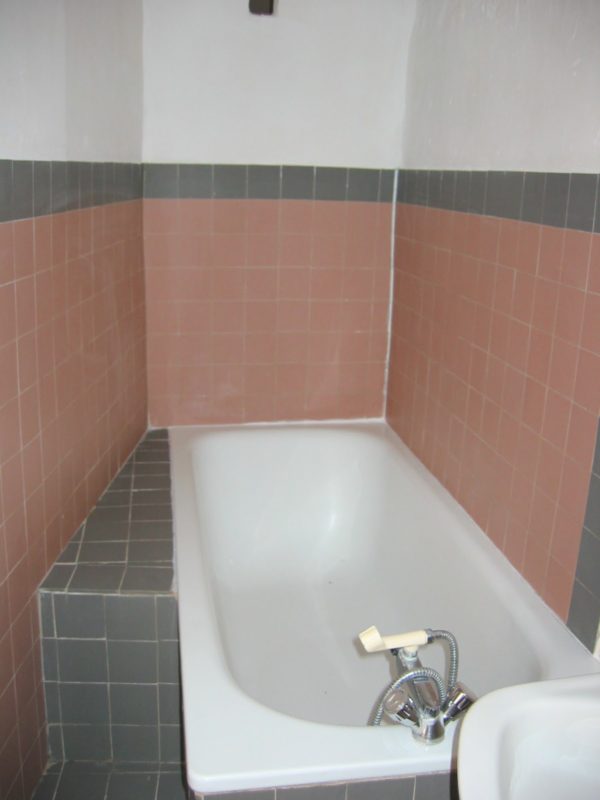 |
| L’Oustaloun bath hidden behind the “monolith”. Photo by W.T. Manfull |
Upstairs was a single room that functioned as the bedroom and bathroom. My eye was helplessly drawn to the far corner where a plaster-covered monolith stood, dwarfing the rest of the room. It was particularly offensive because its height grew from the relatively short wall with the small window to the center of the room where the ceiling was much higher, giving the illusion that it was even larger and much closer to me than it actually was. “Eww” was all I could think. I ventured over to the corner where I found a very long tub stuffed into what was really a very small cavity, despite its appearance from a distance. At the end of the tub, with no wall to offer privacy was a sink (that I could only describe as utilitarian). The toilet was wedged, quite literally, into the corner.
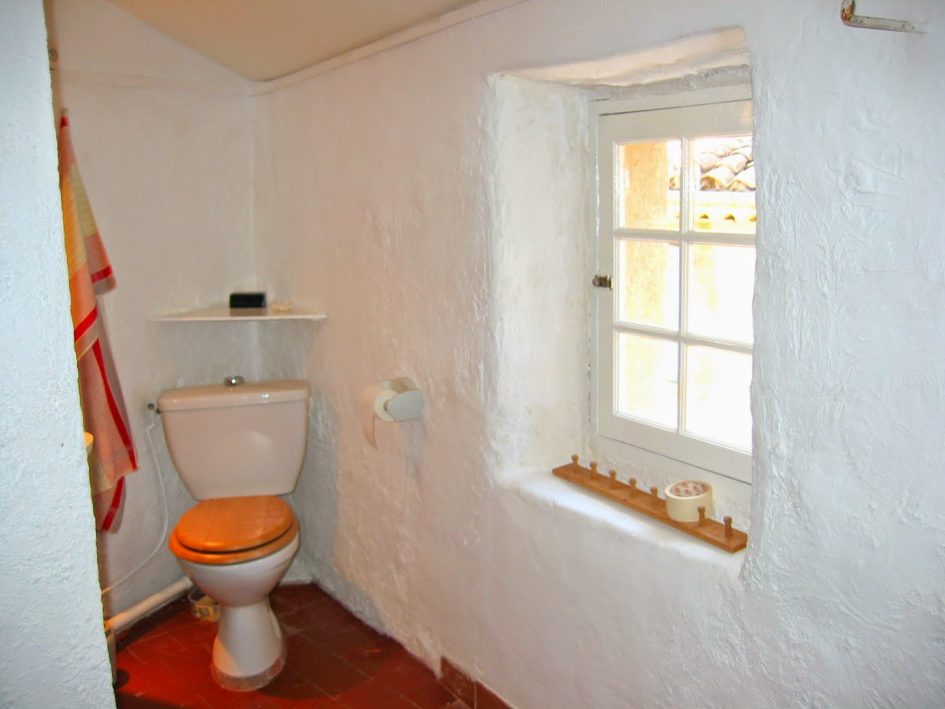 |
| L’Oustaloun. Photo by W.T. Manfull |
Bashfulness was not an option with this set up. I knew immediately that Americans, in particular, would not take kindly to a multipurpose room like this one, but I also knew the monolith had to go and my vision for the room entailed even less privacy (but enabled much more attractive lighting).The late morning sun was streaming in through the small window near the toilet but its path was blocked by the monolith. I suspected that the late afternoon sun would light up the room through the other window that overlooked the courtyard.
Aside from the escalating costs of the renovation plans we were already entertaining—especially in the smaller place where you would think we were recreating Le Petit Trianon of the South—our biggest worry was the courtyard. It didn’t actually come with the two houses. It belonged to the large home that made up the other two sides of the courtyard. We were told that the owner, an elderly man with no children, never used it and that he had in fact boarded up his only door that opened into it. He had always let the owners of the two homes use it. All this was true we confirmed although—spoiler alert—we should have confirmed the status of his health, too.
Our other concerns centered on the cacophony of neighboring homes—who would be responsible for what? At home in the States, we have to work—sometimes negotiate, compromise, and even huff and puff —with just two neighbors over issues like repairing fences and pruning trees. Here, we could count at least a half-dozen neighbors whose property touched or could, in some way, affect our property. We wondered if these multiple joint-responsibilities would be a nightmare, especially in France where every decision typically entails a long discussion in which everyone’s opinion is aired over and over again. And here we lived on a different continent in a different time zone to boot!
Our count of contiguous neighbors had not included Madame Bivet. She lived on the other side of Rue de la Juiverie, adjacent to Madame Ricard. Like most villagers, she had lived there for many years. Her petite size, salt-and-pepper hair, and elegant manner did not prepare us for her power-house personality. She pulled us aside, introduced herself, and informed us, in perfect Parisian French, that she had a “droit de passage.” This, we knew, meant that she had the right to pass through our property. Upon seeing our puzzled faces—“where was she passing through to?”—she explained that she owned a storage room. “Ah,” we gathered, “one of the other two doors off the courtyard!” She liked to enter by passing through “our” courtyard although she could just as easily, it seemed, enter her storage room by walking around the corner.
While relieved to hear her refer to the courtyard as “ours”—even though we had not yet seriously begun to discuss buying the property—the relief was just temporary. We quickly wondered who owned the other door and just how many people might be passing through. Those thoughts were interrupted by Madame Bivet’s next pronouncement. She had always kept her poubelle tucked in the corner of our passageway and hoped that we would not see the need to alter this historic arrangement. (We later noted the garbage can with “Madame Bivet” neatly written across the lid tucked, as she said, in the corner behind the door.)As we mulled this huge decision over and over, we heard from many people in the village. (News like “American family buying maison village” travels quickly.) Everyone seemed to know someone or be related to someone who was a plumber, electrician, tiler, plasterer, woodworker, painter, caretaker, or banker. Visions of Peter Mayle’s year in Provence whirled in our heads.
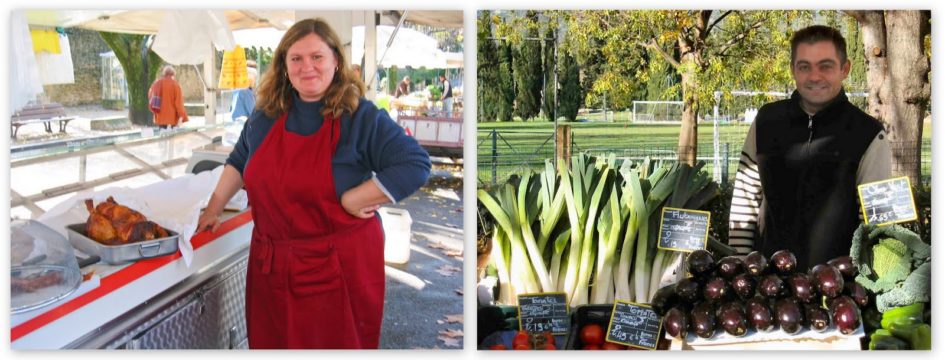 |
| Two of favorite vendors at the Lourmarin market. Photo by W.T. Manfull |
I thought about all the years I had heard my parents bemoan their decision not to buy a “little house on the beach” in Southern California. My father died at the same age I was at the time I contemplated this purchase. My mother, now 84, still talks about the house she wished they had purchased “for a song.”
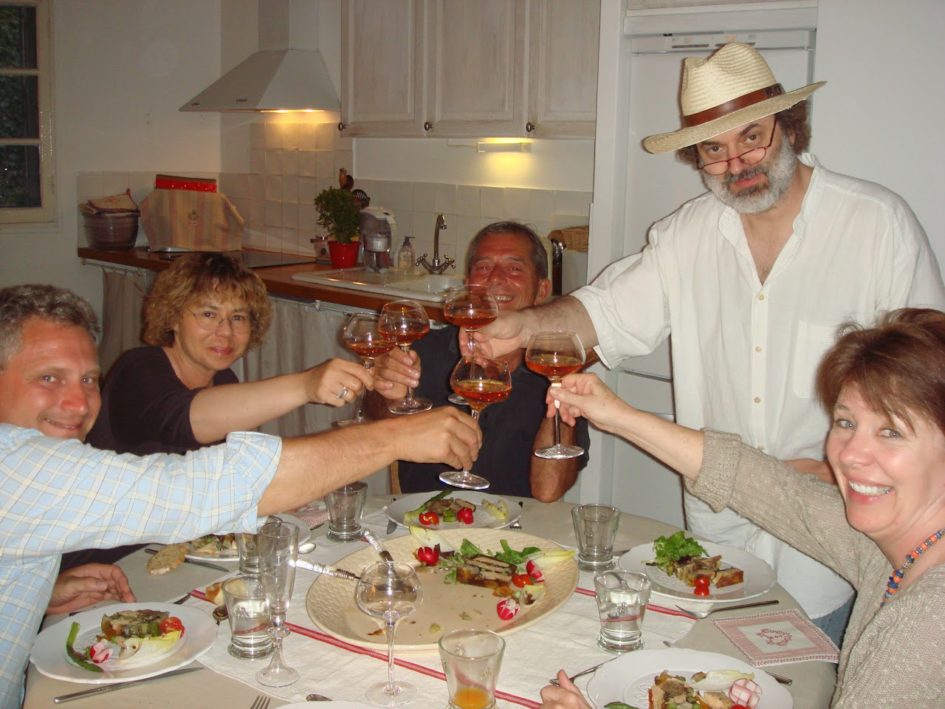 |
| Santé!!! |
Like so many decisions in life, a list of pro’s and con’s—even weighted for significance—may not yield a clear answer. It comes down to what our hearts tell us and whether we listen.
We decided to take out a mortgage because, at the time, the interest rates were remarkably low, less than 2%, and the exchange rate was expected to swing back to favor the dollar soon. In April 2004, when we commenced this process, the exchange rate was $1.20; two years earlier, it was about $.90. (It didn’t work out this way though—in 2008, the exchange rate climbed to the staggering amount of $1.6038, making mortgage payments a lot higher!)
After we agreed to buy the property, the notaire steps into the picture. The notaire is less than an attorney, but much more than a notary public—he (or she, though men dominate the field) is a legal specialist and public officer who handles property, inheritance, and family law.
With the help of our friend Pierre, we named the homes while we waited for the papers to pass. The larger and newer of the two homes would be called “La Bonbonnière” and the older home would be called “L’Oustaloun.
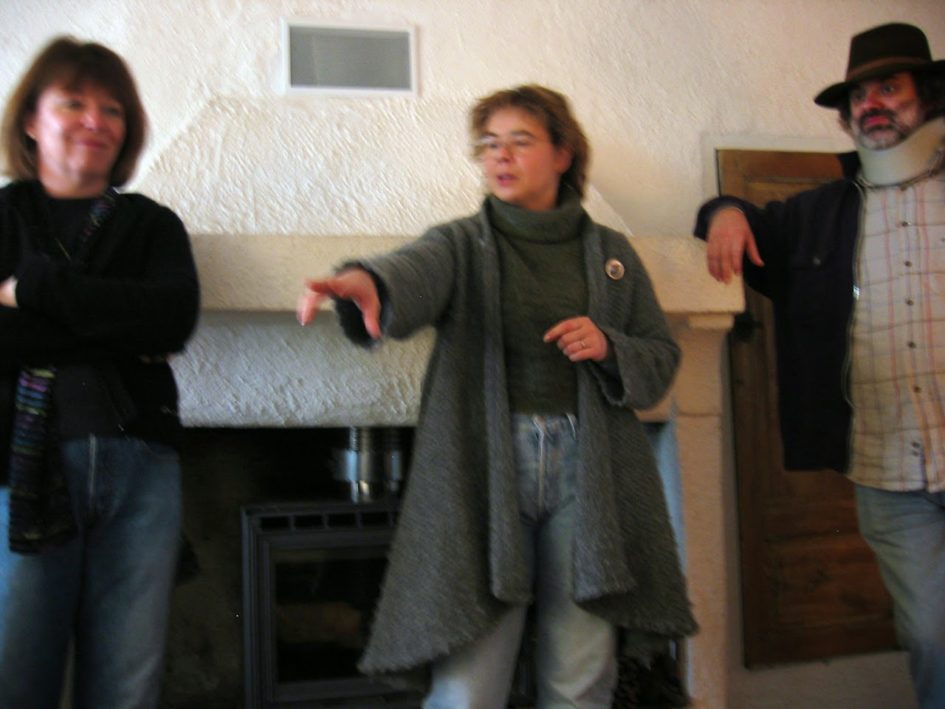 |
| Muriel helping with decorating ideas. |
”Finally, three seasons later, in the fall of 2004, we were homeowners in Provence. Let the champagne flow—there was much to celebrate! Towny’s sister Lisa, along with my long-time friend Patti, came over from the States to help. Pam, my close friend since graduate school, and her companion Hervé from nearby Cotignac were there. Neighbors and friends from the village dropped by. And, bien sûr, Pierre and Muriel were there—none of this would have happened without them.
By day, we went to IKEA, Alinéa, or Interiors to shop for furniture, linens, and dishes. (View video above!) We frequented the weekly markets for more interesting items and groceries. We met with Gérard Isirdi, our friend and favorite painter in the area, to select a couple of his paintings. Towny, a wonderful photographer, framed several of his own pieces to hang. Muriel spent her time choosing fabric for curtains to be made by Régine, a local seamstress and friend who owned Les Cousines des Lilas. Muriel and our daughter perused stacks of books about Provence to help choose the perfect Provençal palette for our walls.
We all got involved in the configuration of the upper floor of L’Oustaloun so that a modicum of privacy was afforded between the bedroom and bath. At the end of many days, we would rendezvous upstairs—with measuring tapes and draft paper—to discuss possibilities and enjoy aperitifs. (Really, if you have never had aperitifs in the bathroom, you just haven’t lived!)
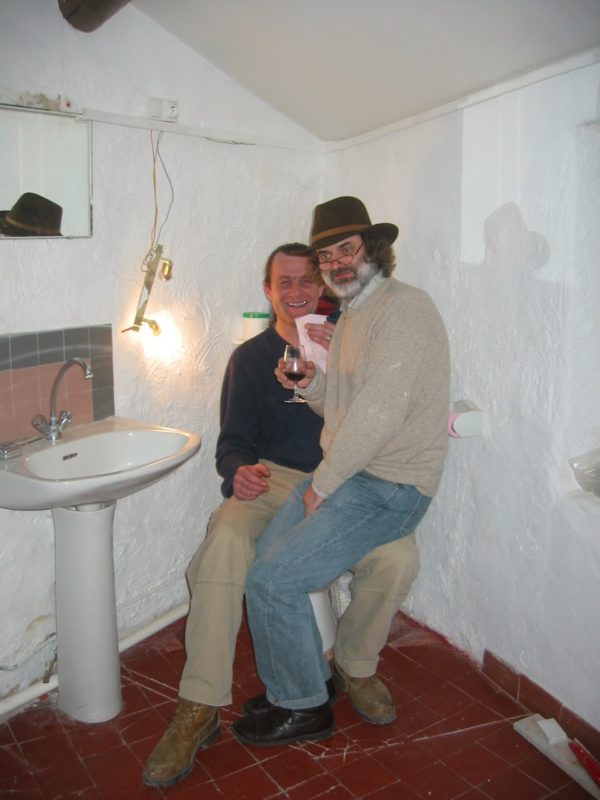 |
| Doing research |
This inevitably involved each of us sitting on the toilet to assess how high and deep a half-wall would need to be for privacy. Nothing short of a fully enclosed toilet would satisfy some people—especially our American friends—but then I asked myself, “Would we want those kind of people in our bedroom anyway?”
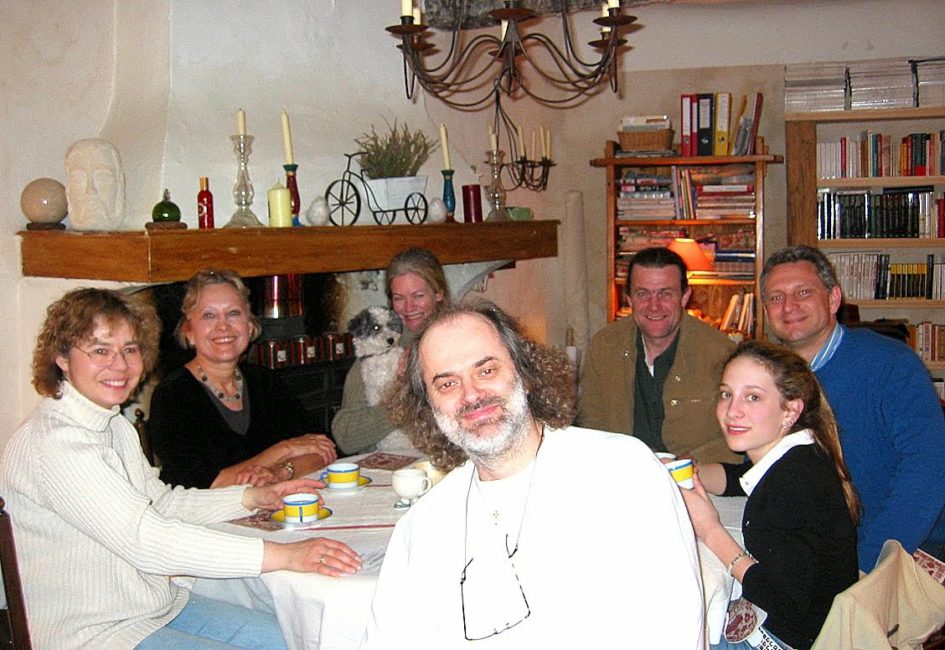 |
| A wonderful dinner after a hard day’s work |
Every evening, we gathered for dinner. Sanguine toasts, clinking glasses, seasonal cuisine, drôle stories, and lots of laughter characterized these evenings, and are indelibly etched in my mind.
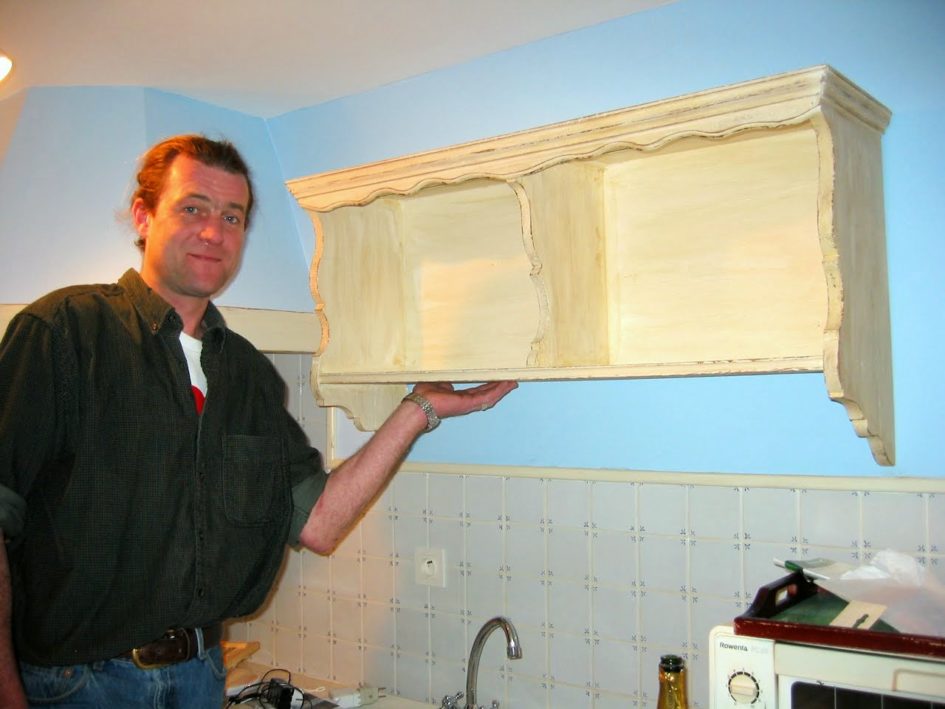 |
| Hervé mounting a shelf in La Bonbonnière. Photo by W.T. Manfull |
Readers of A Year in Provence would be disappointed if we didn’t have a few stories about workers who enjoyed a tipple or two too many. And have them we do! But it is much too soon to be telling those tales.
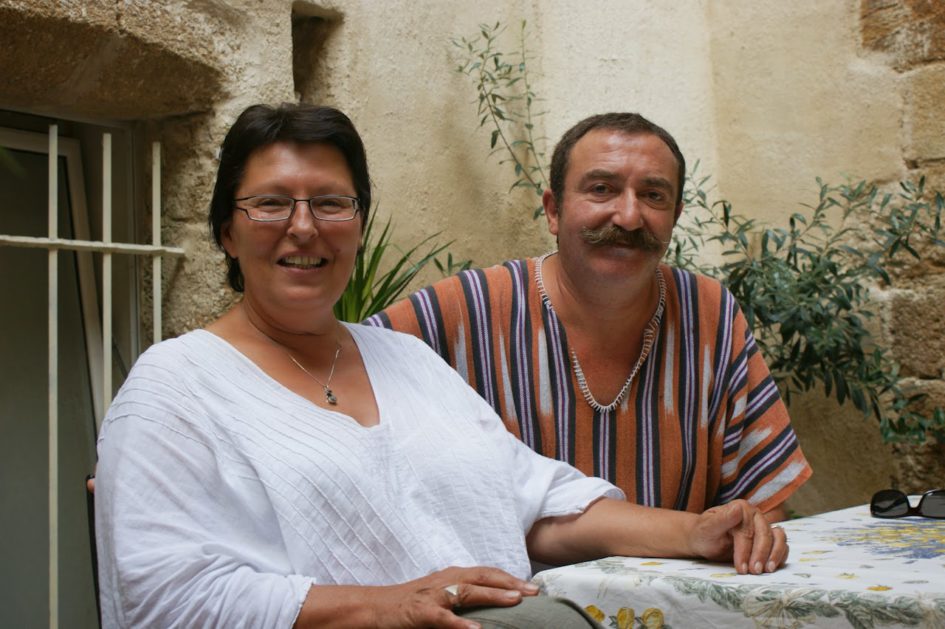 |
| Joël and Christine, caretakers for La Bonbonnière and l’Oustaloun. Photo by W.T. Manfull |
We began to interview people for caretaking La Bonbonnière and L’Oustaloun in our absence, and for future vacation renters. We were very fortunate to meet Joël and Christine who eventually fulfilled this role, as well as acting as our liaison with the contiguous neighbors when, as we predicted, “la merde a frappé le ventilateur.” (The French don’t actually use that idiom, but it sounded so much nicer than, “the shit hit the fan.”)
The elderly man who owned that home and who had, for all those years allowed his courtyard to be used by the previous owners, died just a few months after our purchase was consummated. The heirs, when finally located and finally able to come to an agreement, decided to sell the home to a developer who made plans to divide the property into individual units—a copropriété or condominium complex.
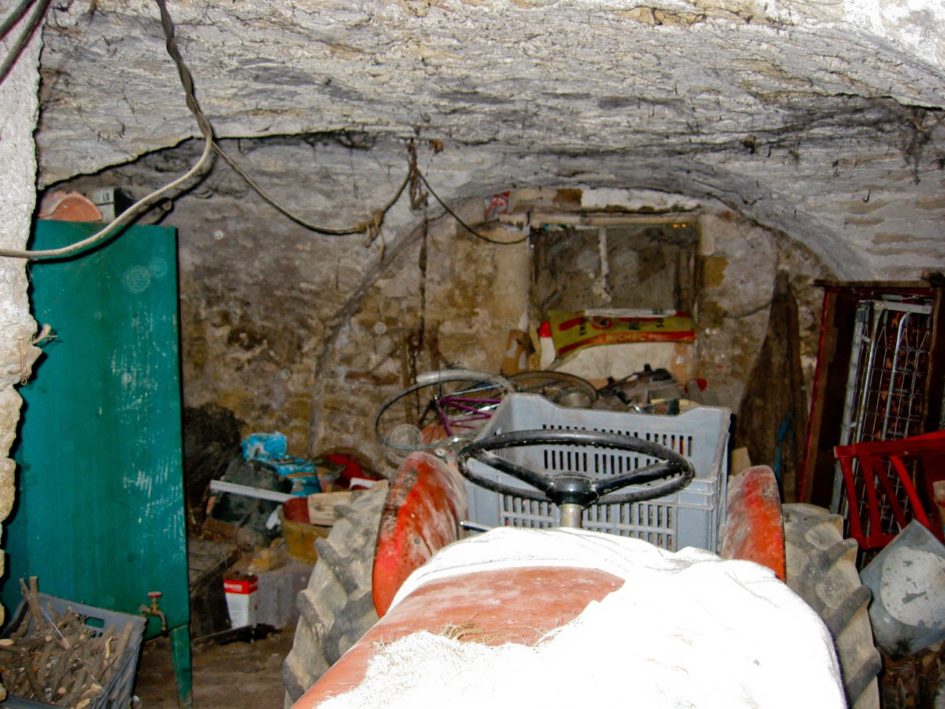 |
| Farm equipment awaiting removal from the bergerie (sheep pen) we purchased. Photo W.T. Manfull |
In order for us to keep the sweet courtyard that had made us fall in love with the maison village to begin with, we would need to buy the bottom floor of the neighboring home. It was an oddly shaped space, filled with farm equipment, with an earthen floor where sheep had once been kept—evidence of their presence was still pervasive.
______________________
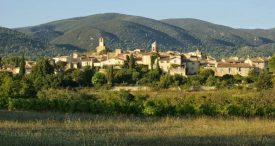
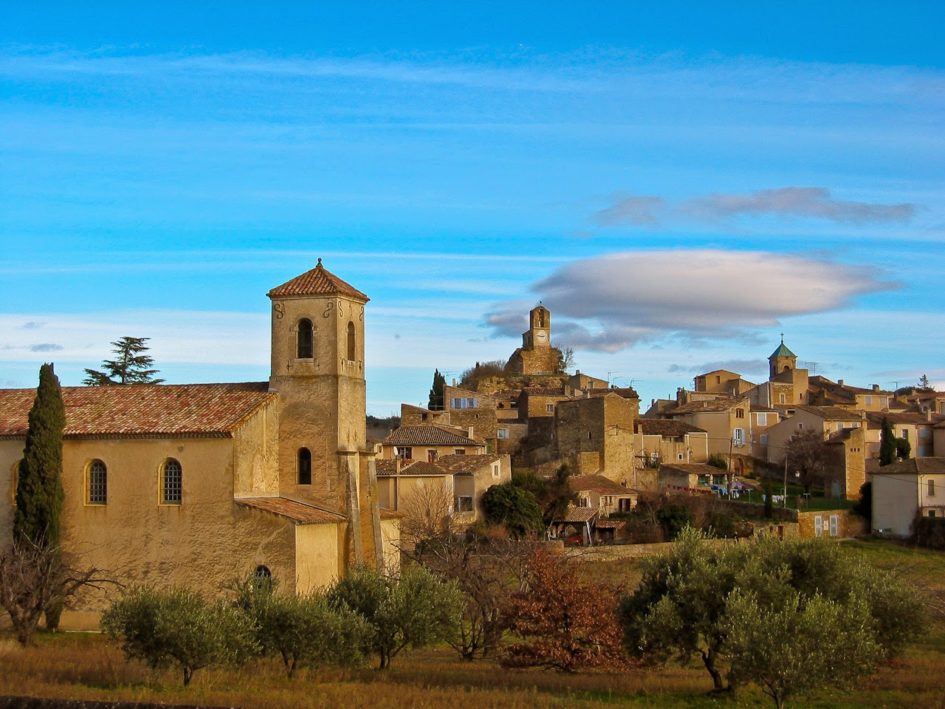
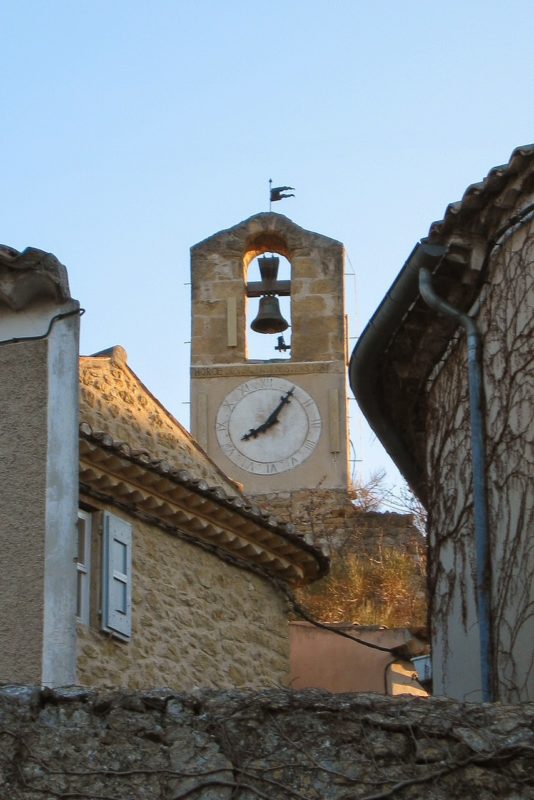
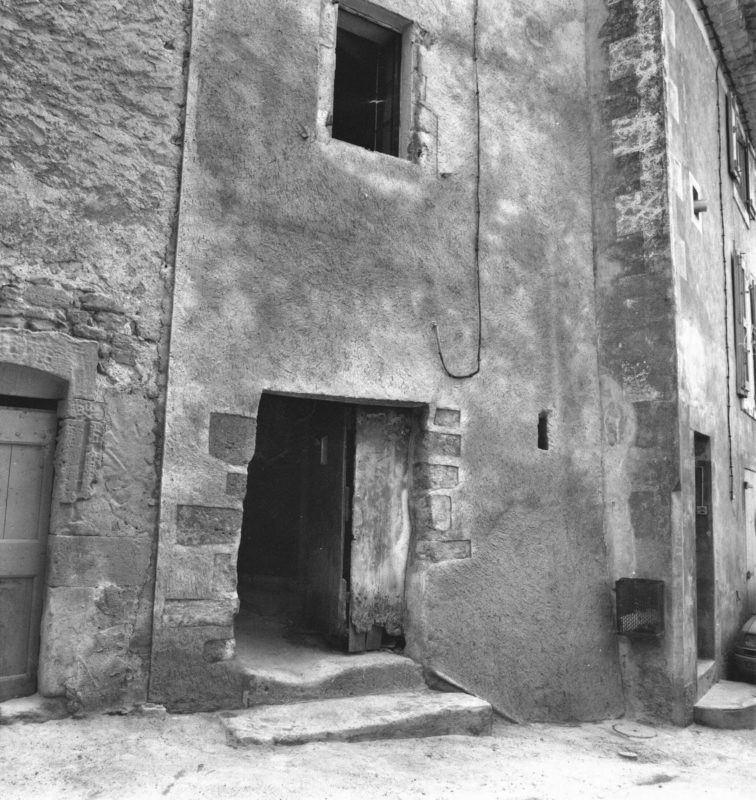
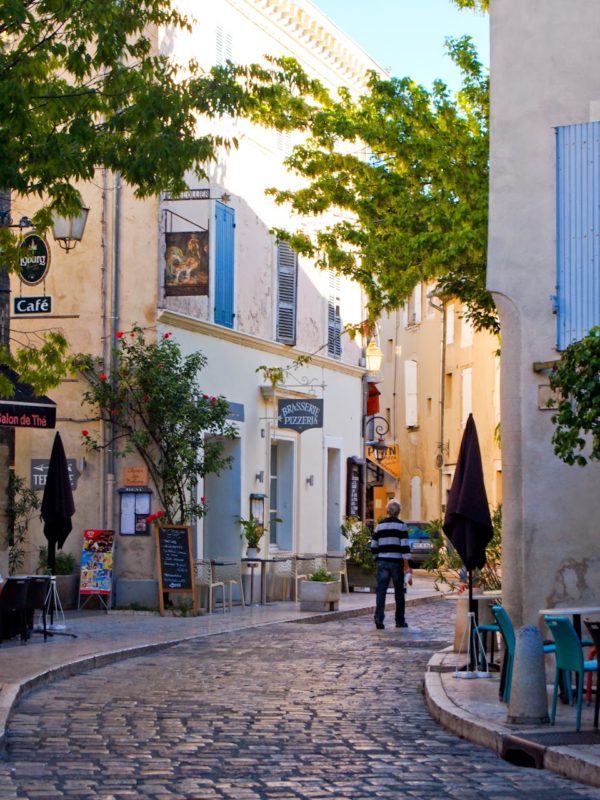
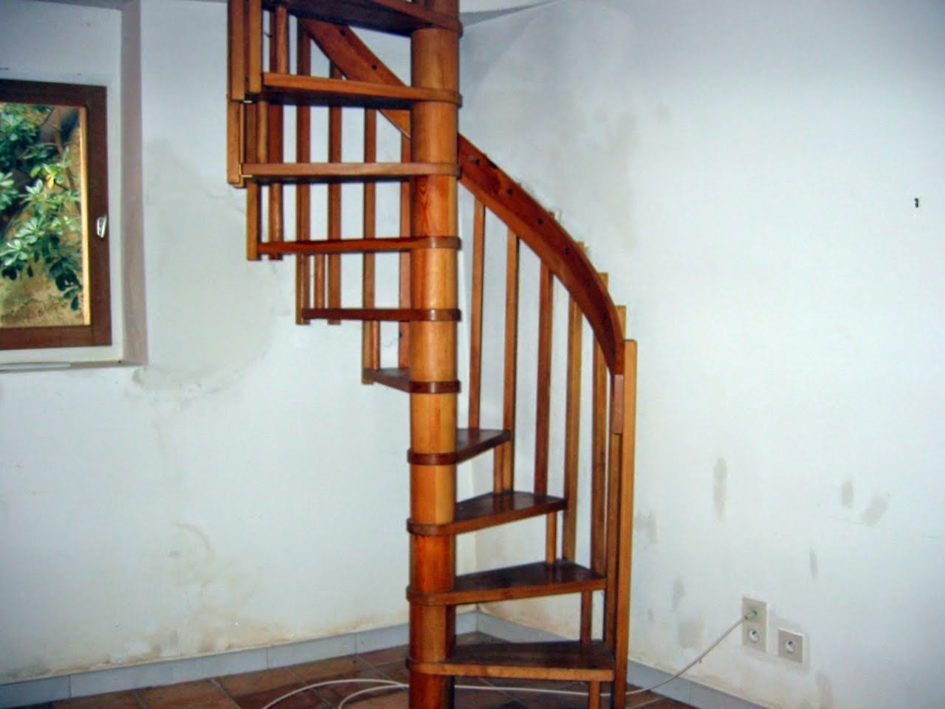
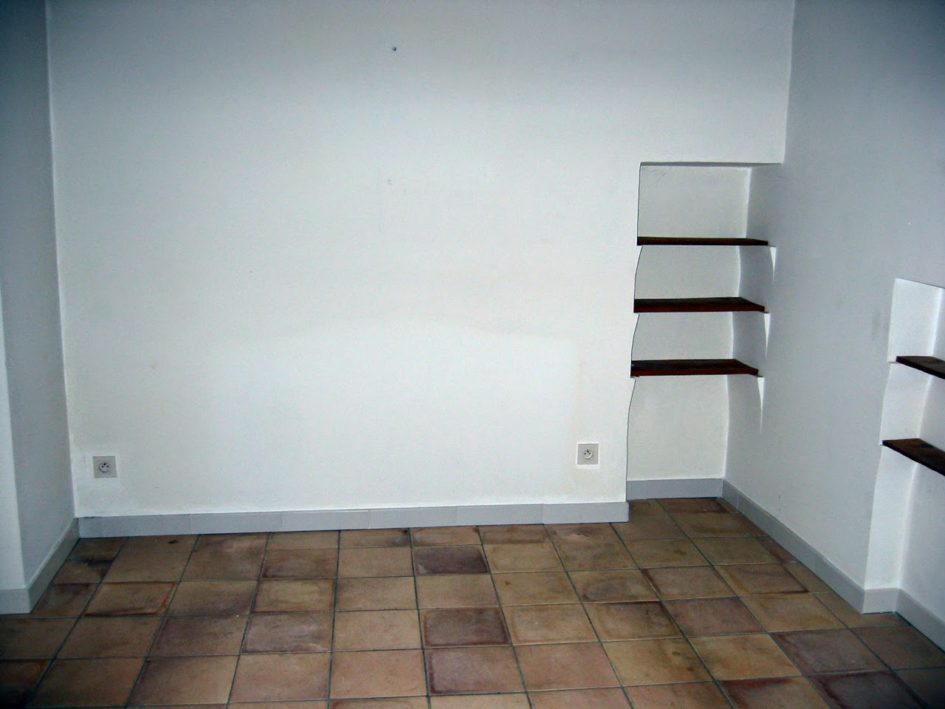
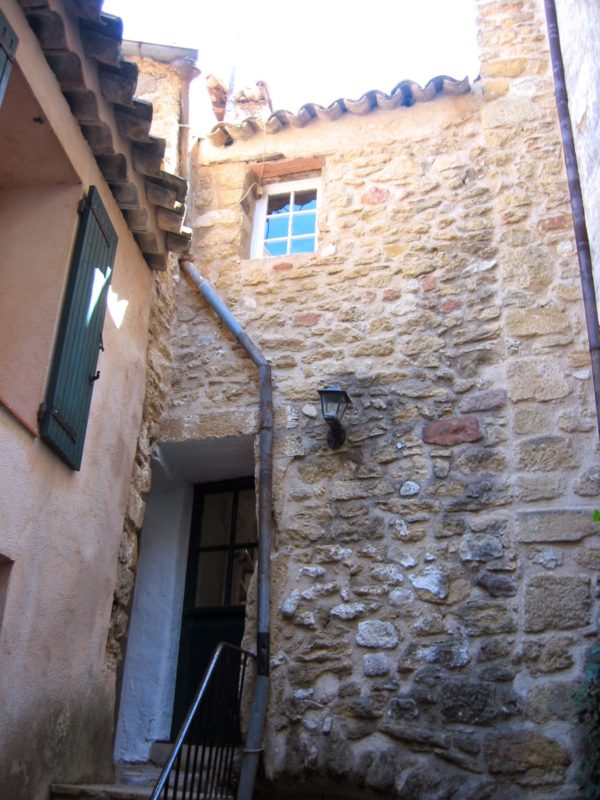
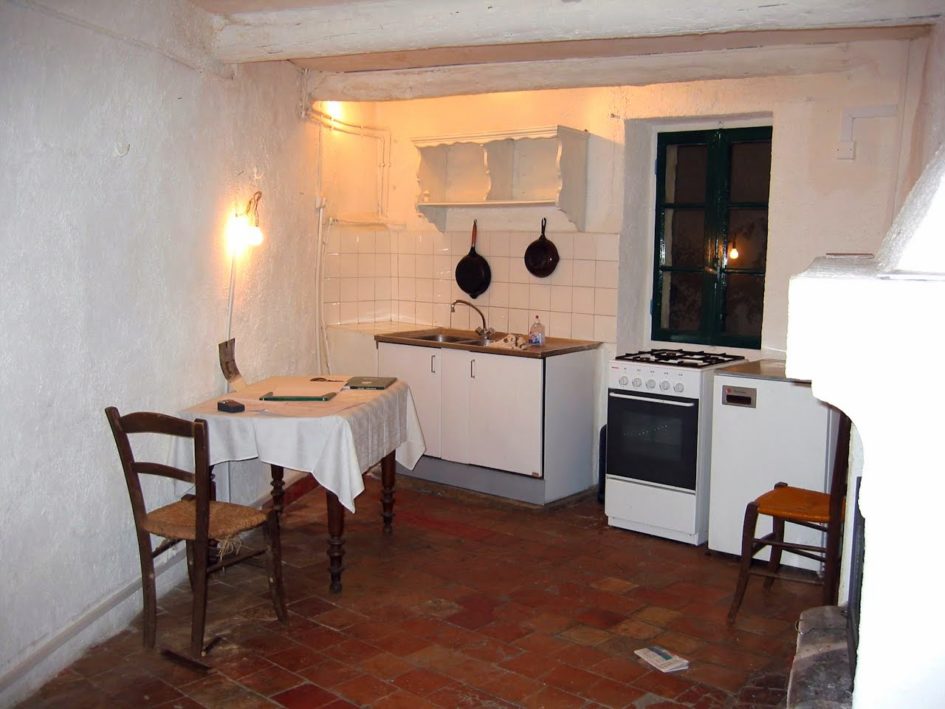
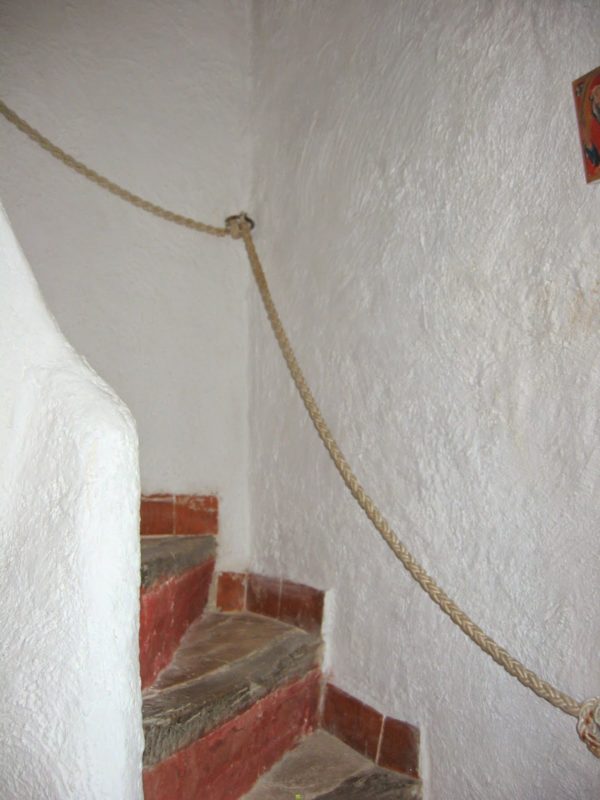
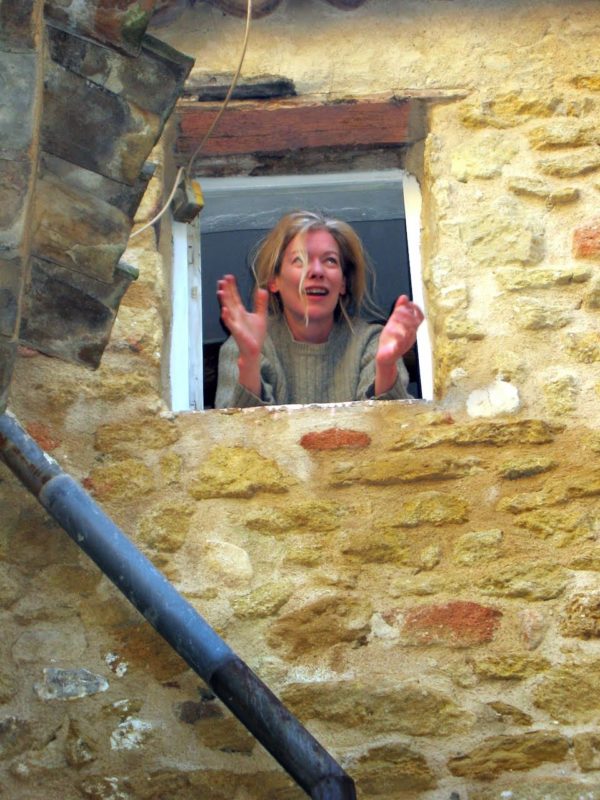
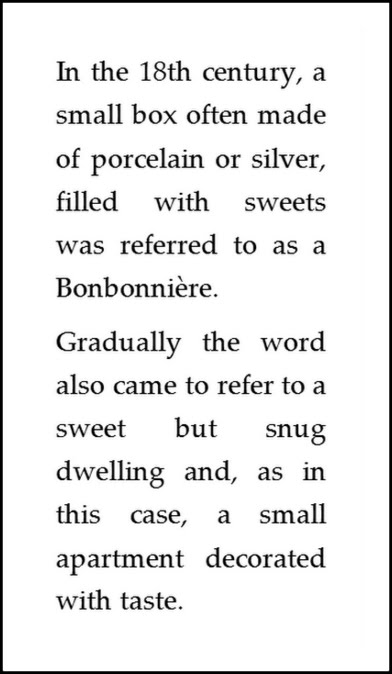
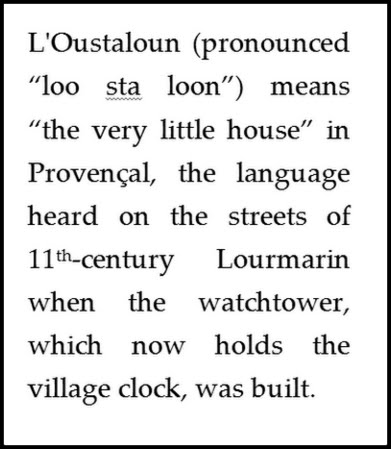
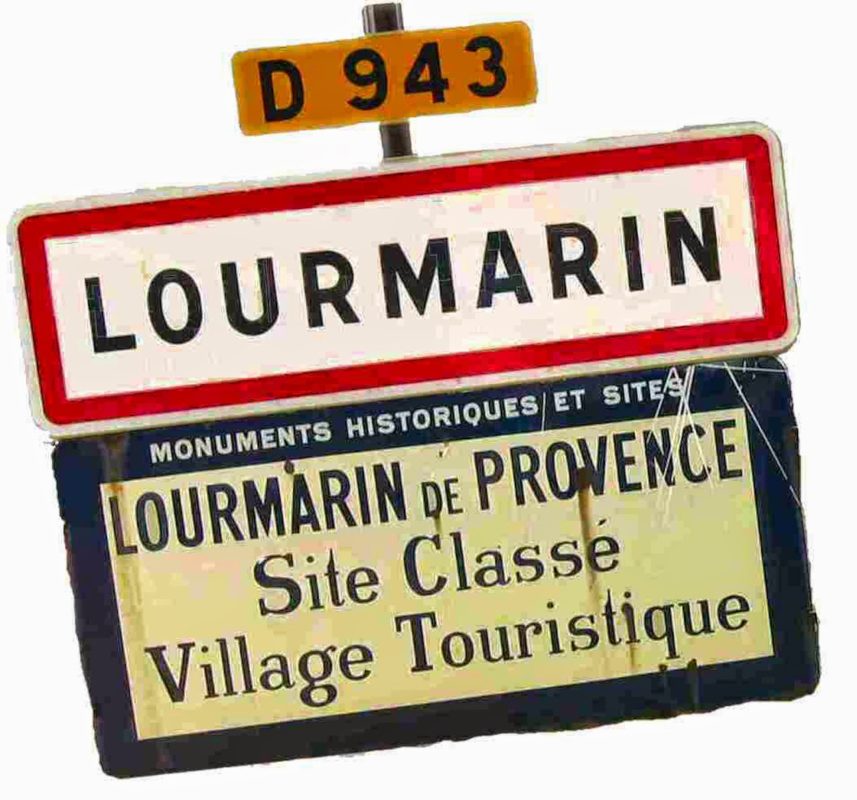
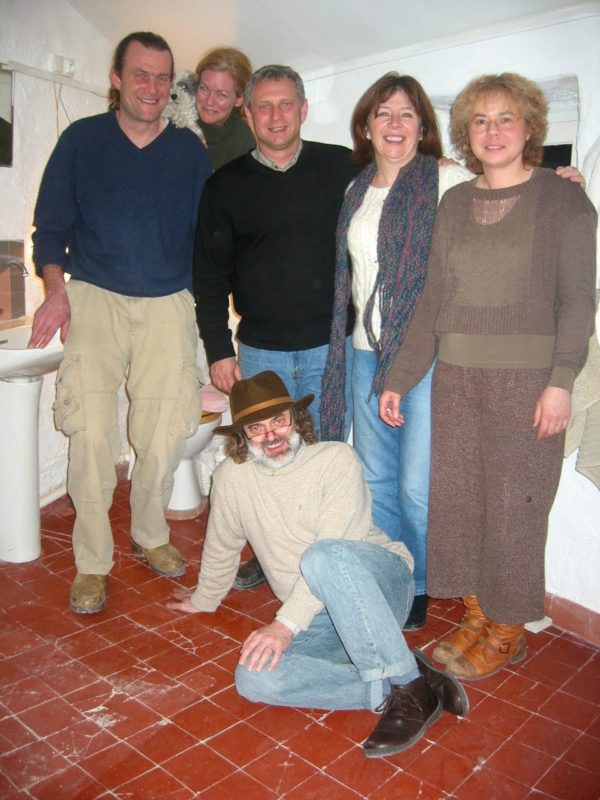
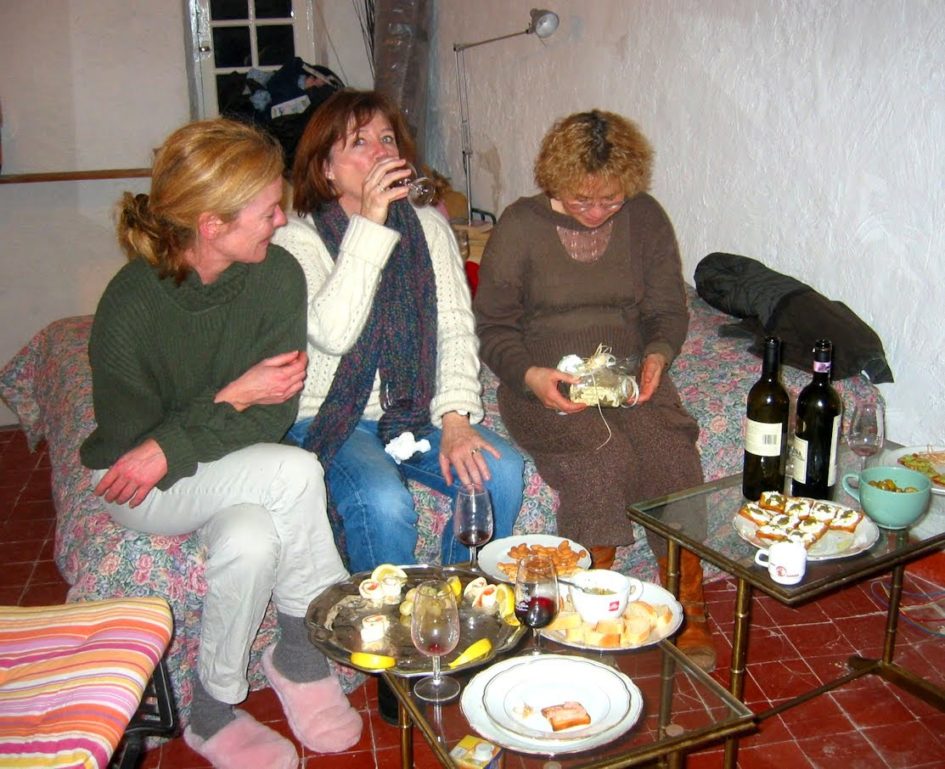
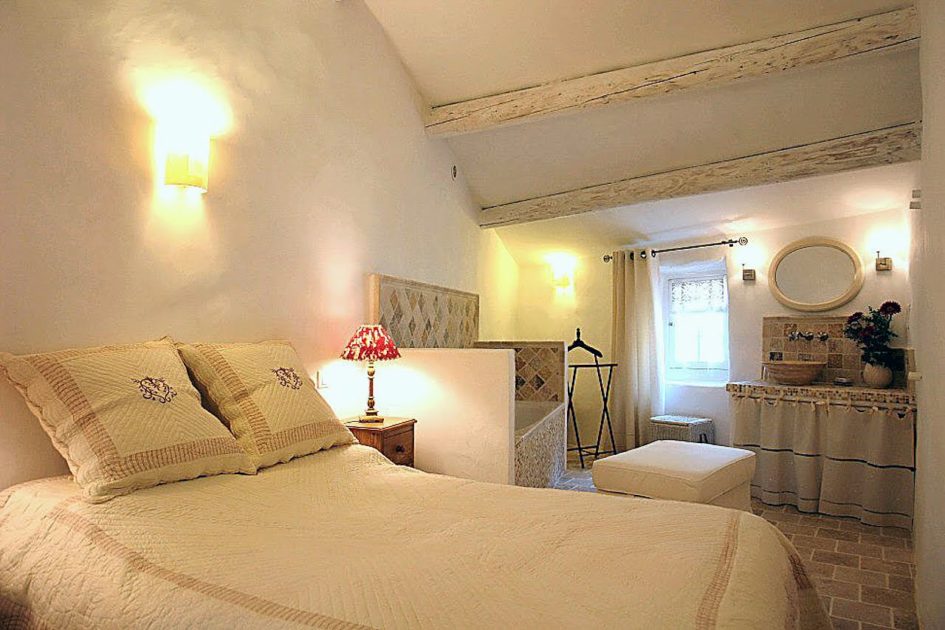





Hi Susan,
I loved reading the story of your homes in Loumarin and the video was really fun. Two years ago we traveled through Provence and the Languedoc to view several homes which had shares for sale. In each case the 5 homes were the grandest in the village and beautifully furnished. Sadly, most were in dying wine villages and so we did not purchase. We had been interested in purchasing our own fixer…but you are right in your statement that you must speak fluent French…lucky, lucky you that you have mastered French…Congrats on a beautiful reno and sale. :0)
What an incredible journey! The photos are great, and the video really adds so much! Great job, Alex! I am not sure if I had seen the empty shells, if I would have had the vision you had for these tow homes. I am so glad we had the chance to stay in L'Oustaloun that wonderful summer…
Your Mother's story of missing the chance to buy a California beach house when she could have bought one for a song, we call that an "if only I da" real estate tale. So good for you plunging ahead with your home in Provence. Merci Kathy
Misty water colored memories… This feels like it was yesterday and a thousand years ago all at once. What a wonderful time. Champagne in espresso cups and coctails on the commode. Got a little weepy watching Alex's video. Makes me want to do it all again. Would we? Could we?
You are exactly right. We didn't want to say "If only I da" years down the path of life. And now, while we no longer own the Provence property, we have some wonderful memories and wonderful friends.
The vision for the project came from many brain-storming sessions. It would have been so fun to have you and Mark on the team!
Hi Denise,
Thanks so much for your note. You are right–where you choose to buy is so important. You can't take the house out of the village, so you have to love the house and the village! And re speaking French, at least one of us mastered French–my husband–I need another immersion course to revive mine! Or, as a good friend always says, "You could buy another house!"
The wonderful memories Chet and I have of staying in your apartment was enhanced by reading your blogg complete with video and photos. It is a very special place and town. I can understand why you could not resist taking the plunge. We are so glad you went for it. We are spending three weeks in France next month, but sadly won't be traveling to Lourmarin. Next time for sure. Thank you for your blogg that I look forward to reading regularly! Mary Jane
Hi Mary Jane,
Thanks for your lovely note. Stay tuned for a post on "renting the apartment" and another on "selling it". Where will you be in France? I will be going over soon and hope to finally get to Lou Pebre, per your recommendation (and that of many others). I love your painting of a scene from Lou Pebre!
how lovely to read your blog minutes after I had put in a request to rent it for a week this July! Do you still own it?!